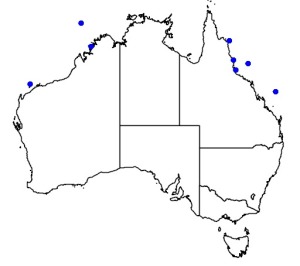�
�

©Anne Hoggett: Ctenactis echinata about 35 cm long, immediately before spawning at about 9:30 pm on 20 Nov 2016 at Big Vicki's Reef, Lizard Island. This specimen appears to have two mouths but this may be due to an injury at the site where the mouths meet.

©Anne Hoggett: Ctenactis echinata immediately after one of several forceful spurts of spawning, at about 9:30 pm on 20 Nov 2016 at Big Vicki's Reef, Lizard Island. Successive spurts were separated by a minute or two.
�
���
Ctenactis echinata

©Anne Hoggett: Ctenactis echinata about 35 cm long, immediately before spawning at about 9:30 pm on 20 Nov 2016 at Big Vicki's Reef, Lizard Island. This specimen appears to have two mouths but this may be due to an injury at the site where the mouths meet.

©Anne Hoggett: Ctenactis echinata immediately after one of several forceful spurts of spawning, at about 9:30 pm on 20 Nov 2016 at Big Vicki's Reef, Lizard Island. Successive spurts were separated by a minute or two.
Kingdom
Animalia
Phylum
Cnidaria
Class
Hexacorallia
Order
Scleractinia
Family
Fungiidae
Genus
Ctenactis
Species
Ctenactis echinata
Status
least concern
Colours
Distinguishing features
A fungid coral that forms an elongate skeleton up to 35 cm long. Septal teeth are well developed. Only a single mouth is present. Colour is typically brown.
Size
- Up to 35 cm (Length)
Synonyms
Similar taxa
-
Animalia:
species: Ctenactis crassa
has several mouths and the axial furrow extends almost to the end of the skeleton (Veron, 2000).
Distribution
Distribution and habitat preferences
Reef fronts, lagoons.
Can be found in most habitats around Lizard Island.
Behaviour
C. echinata is a gonochoric broadcast spawner. In Japanese populations from Okinawa, the species was shown to be protandrous with the capability for bi-directional sex change. In Red Sea populations, it takes approximately 10-12 years to reach the maximum size of 200mm.
Web resources
References
References that assist with identification
- Veron, J.E.N. (2000). Corals of the World: Volume 2 Australian Institute of Marine Science, Townsville.
Other references
- Baird, A.H., J.R. Guest and B.L. Willis (2009). Systematic and biogeographical patterns in the reproductive biology of scleractinian corals, Annual Review of Ecology, Evolution and Systematics, 40: 551-571.
- Dinesen, Z.D. (1983). Shade-dwelling corals of the Great Barrier Reef, Marine Ecology Progress Series, 10: 173-185. LIRS catalog number 157.
- View all references


